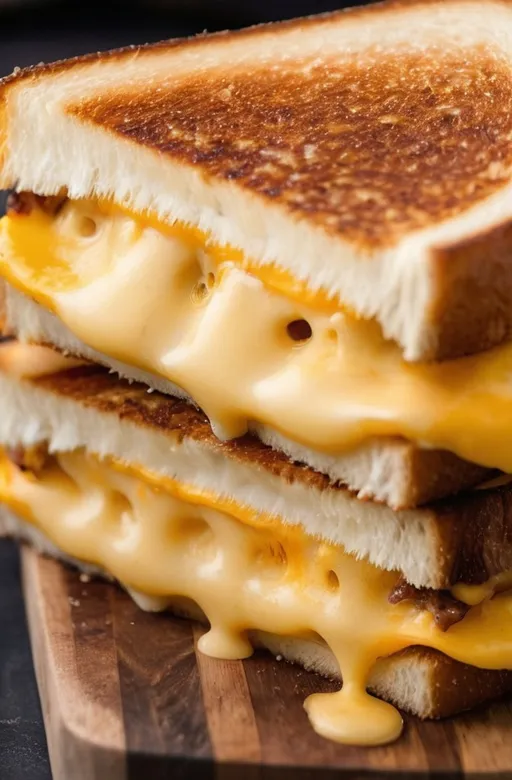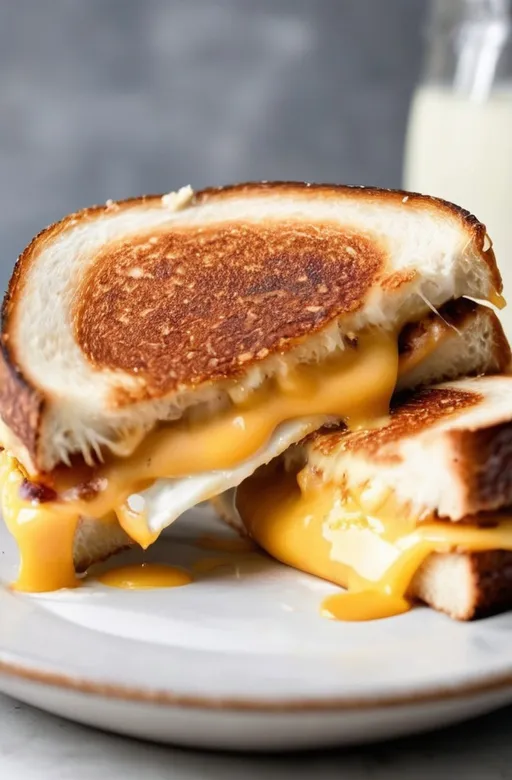Ever found yourself staring into the fridge at 7am, craving something more exciting than cereal but too sleepy for anything complicated? Lemme tell you, breakfast grilled cheese might just change your entire morning routine. I stumbled upon this concept years ago during a particularly rough hangover, when my brain short-circuited between wanting breakfast and lunch simultaneously. The result? Pure morning magic.
Breakfast grilled cheese isn’t just a sandwich—it’s a revolutionary approach to the first meal of the day. By combining the familiar comfort of grilled cheese with classic breakfast ingredients, you’ve got yourself a handheld morning masterpiece that satisfies in ways traditional breakfast simply can’t. The beauty lies in it’s versatility and ability to transform leftover ingredients into something extraordinary.
1. Ingredients & Substitutions
The Foundation: Bread & Cheese
The bread you choose creates the architectural foundation for your breakfast masterpiece. Sourdough offers tangy notes and structural integrity, while brioche brings a subtle sweetness and enriched texture. Country white provides comfort and nostalgia, and rye adds earthy depth that pairs beautifully with savory breakfast meats.
Cheese selection is where breakfast grilled cheese transcends it’s lunchtime cousin. While sharp cheddar provides familiarity and excellent meltability, consider exploring alternatives. Gruyère offers nutty depth that complements eggs sublimely. Pepper jack brings welcome heat to sleepy taste buds. American cheese, despite it’s processed reputation, melts impeccably and delivers that classic diner-style unctuosity that many breakfast foods benefit from.
For dairy-free options, cashew-based vegan cheeses tend to melt better than their coconut oil counterparts. Plant-based slices have come lightyears ahead in terms of meltability—just look for ones specifically marketed for their melting properties.
Breakfast Elements
Eggs form the protein cornerstone of most breakfast grilled cheese variations. Scrambled eggs should be slightly underdone when preparing, as they’ll continue cooking inside the sandwich. Fried eggs with runny yolks create a natural sauce element, though they require careful sandwich construction to prevent excessive leakage. Hard-fried eggs provide textural contrast without the messiness.
Breakfast meats add smoky, salty dimensions that elevate the entire experience. Bacon should be cooked to your preferred doneness—remember that it won’t crisp further inside the sandwich. Breakfast sausage benefits from being broken into crumbles rather than sliced, ensuring better distribution. Ham slices should be pan-seared briefly to develop caramelization and render some fat.
Vegetarian protein alternatives work beautifully too. Tempeh bacon provides earthy complexity. Vegetarian sausage crumbles bring protein and spice without heaviness. Seasoned tofu scramble with black salt (kala namak) delivers remarkable egg-like flavor while keeping things plant-based.
Accent Ingredients
Fresh vegetables introduce brightness and textural contrast. Consider thinly sliced tomatoes (seeds removed to prevent sogginess), avocado slices, spinach leaves, or quickly sautéed bell peppers and onions.
Condiments and spreads deserve thoughtful consideration beyond basic butter. Herb-infused mayonnaise creates rich complexity—try mixing mayo with chopped chives, dill, or tarragon. Sweet elements like maple butter or a thin layer of fig jam create fascinating sweet-savory interplay. Hot sauce, particularly smoky varieties, wakes up the entire flavor profile.
2. Step-by-Step Instructions

Preparation
Begin by properly organizing your mise en place. Cook and prepare all fillings before assembling the sandwich—scramble eggs, cook meat, slice vegetables, and grate cheese if not using pre-sliced. This prevents the dreaded “half-cooked filling syndrome” that plagues rushed sandwich construction.
Heat your cooking surface (cast iron skillet, non-stick pan, or flat griddle) over medium-low heat. The most common mistake in grilled cheese preparation is excessive heat, which burns the bread before properly melting the cheese. Medium-low allows for gradual heat transfer through the bread to the filling.
Butter your bread slices on the outward-facing sides only. A thin, even layer works better than thick applications, which can create spotty browning. Alternatively, mayonnaise on the exterior creates exceptional browning due to its combination of oil, egg proteins, and a touch of sugar.
Assembly & Cooking
Layer strategically to prevent slippage and ensure even heat distribution. Place a thin layer of cheese directly on the bread as “glue” before adding egg and meat elements. Another cheese layer on top of fillings helps bind everything together during melting.
For ingredient-heavy variations, consider the “partial pre-melt” technique. Place the bottom bread slice with cheese in the pan, allow cheese to begin melting, then add remaining ingredients. This creates a stable base layer.
When cooking, patience reigns supreme. Cover the pan during cooking to trap heat, helping cheese melt before bread over-browns. For especially thick sandwiches, finishing in a 300°F oven for 3-4 minutes ensures thorough heating without risking burnt exterior.
Flip only once, using a wide spatula with decisive movement. Press gently with spatula after flipping to ensure good contact between all elements. The finished sandwich should feel cohesive when lifted—if ingredients shift independently, it needs more time for proper cheese melting.
Finishing Touches
Rest your completed breakfast grilled cheese for approximately 60 seconds before slicing. This brief pause allows cheese to stabilize, preventing the dreaded “filling avalanche” that occurs when cutting immediately after cooking.
For presentation, a diagonal cut showcases the colorful layers of your creation. This simple technique elevates the visual appeal dramatically. For especially cheese-centric versions, the slow-pull break-apart provides Instagram-worthy cheese stretching opportunities.
3. Cooking Techniques & Science
The magic of breakfast grilled cheese happens at the molecular level through several concurrent processes. The Maillard reaction—that beautiful browning when proteins and sugars meet heat—creates hundreds of new flavor compounds on the bread’s surface. This same reaction occurs with your eggs and breakfast meats, compounding complexity.
Temperature control separates amateur from expert execution. The ideal cooking environment maintains heat between 325-350°F. This range ensures proper browning while allowing time for thermal transfer through the bread to melt cheese fully. Higher temperatures create visually appealing but texturally disappointing results—beautiful exterior with cold, unmelted centers.
Fat plays multiple crucial roles beyond flavor. The butter or mayonnaise on bread’s exterior conducts heat uniformly across the surface while preventing sticking. It also fills micro-crevices in the bread, creating complete contact with the cooking surface for even browning. Inside, fat from cheese and meats distributes flavor compounds throughout each bite while providing that characteristic creaminess.
The cheese’s protein structure undergoes fundamental transformation during cooking. As temperatures rise, calcium-protein bonds temporarily break, allowing proteins to flow. Upon cooling slightly, these bonds reform in new positions, explaining why properly melted cheese doesn’t immediately separate when bitten.
4. Signature Variations
The Classic Morning Glory
This baseline version pairs scrambled eggs with bacon and sharp cheddar on sourdough. The secret lies in adding a pinch of nutritional yeast to the scrambled eggs, enhancing cheesy flavor dimensions without heaviness. A light spread of whole grain mustard introduces pleasant pungency that cuts through richness.
The Farmer’s Market Fresh
For a produce-forward option, layer spinach, thin-sliced heirloom tomatoes, and avocado with scrambled egg whites and goat cheese on multigrain bread. The interplay of creamy avocado with tangy goat cheese creates sophisticated balance, while vegetables provide freshness. The trick is salting and patting tomato slices dry before assembly to prevent sogginess.
The Weekend Warrior
For indulgent weekend mornings, this substantial variation layers maple-glazed bacon, a fried egg, caramelized onions, and smoked gouda on brioche. The sweet-savory combination creates complex depth, while the runny egg yolk functions as a natural sauce. Pro tip: create a slight depression in the center of your sandwich to catch the yolk when you cut into it.
The Mediterranean Sunrise
Featuring scrambled eggs with herbs, roasted red peppers, spinach, and feta on olive bread, this variation brings bright Mediterranean flavors to your morning. The key technique involves quickly sautéing spinach with microplaned garlic before adding to the sandwich, introducing aromatic depth without overpowering.
5. Serving & Pairing Suggestions
Breakfast grilled cheese deserves thoughtful accompaniments that enhance rather than compete. Fresh fruit provides cleansing brightness against the sandwich’s richness—berries and sliced stone fruits work particularly well. Citrus segments offer palate-refreshing acidity that cuts through cheese and butter.

For beverage pairings, consider contrast and complementary elements. Black coffee’s bitterness creates wonderful counterpoint to the sandwich’s richness. Fresh-squeezed orange juice provides acidic balance. For weekend indulgence, mimosas or a spicy Bloody Mary enhance the breakfast experience through effervescence or savory depth, respectively.
Presentation need not be complicated. Serving on a wooden board with fresh fruit creates rustic elegance. A small ramekin of maple syrup for dipping adds interactive fun and sweet flavor contrast. For brunch gatherings, consider cutting into quarters and serving alongside other breakfast favorites for variety.
6. Troubleshooting Common Issues
Soggy bread typically results from three potential errors: wet fillings, insufficient heat, or improper assembly. Always thoroughly drain watery ingredients like tomatoes or sautéed vegetables. Ensure your cooking surface reaches proper temperature before adding the sandwich. Finally, create moisture barriers by placing cheese directly against bread slices with wetter ingredients centered.
Unmelted cheese usually indicates either insufficient cooking time or improper ingredient temperature. Starting with room-temperature cheese (15-20 minutes out of refrigerator) significantly improves melting. Additionally, covering the pan creates a mini-oven environment that encourages thorough melting.
Burnt exterior with cold interior suggests heat that’s too high. Lower temperature and longer cooking time allows for proper heat penetration. Remember that perfect grilled cheese requires patience—rushing leads to disappointing results.
Sliding ingredients plague hurried assembly. Beyond the cheese-as-glue technique mentioned earlier, allowing your completed sandwich to rest for 60-90 seconds before cutting dramatically improves structural integrity as melted cheese slightly firms up.
7. Make-Ahead and Scaling Strategies
While freshly made breakfast grilled cheese represents the gold standard, mornings often demand efficiency. For meal prep scenarios, consider preparing component parts rather than complete sandwiches. Pre-cooked bacon, portion-ready scrambled eggs, and pre-sliced cheese can be refrigerated for 2-3 days, enabling quick assembly.
For feeding crowds, the sheet pan method proves invaluable. Assemble multiple sandwiches, brush exteriors with melted butter, and arrange on parchment-lined baking sheets. Bake at 425°F for approximately 8 minutes, flip, and continue baking until golden brown (about 5-6 minutes more). This approach lets you serve everyone simultaneously rather than in shifts.
Freezing fully assembled (but uncooked) breakfast grilled cheese works surprisingly well for meal preparation. Wrap individual sandwiches tightly in parchment then foil, freeze on a flat surface, then transfer to storage containers. Cook from frozen by starting at lower temperature (300°F) then increasing to standard temperature after thawing occurs.
Conclusion
Breakfast grilled cheese represents the perfect intersection of comfort food tradition and morning innovation. Its brilliance lies in adaptability—the format welcomes endless variation while remaining fundamentally satisfying and accessible. Whether you’re cooking for yourself on a lazy weekend or impressing brunch guests, mastering this technique adds valuable versatility to your culinary repertoire.
The beauty of breakfast grilled cheese extends beyond flavor. It offers efficient nutrition delivery, portable convenience, and the ability to transform leftovers into something extraordinary. The next time you find yourself in a breakfast rut, remember that between two slices of bread lies infinite morning possibility.
FAQs
Can I prepare breakfast grilled cheese the night before?
You can pre-assemble components, but complete assembly is best done just before cooking. If time constraints demand advance prep, assemble the sandwich without buttering the exterior, wrap tightly in parchment, and refrigerate overnight. In the morning, butter the exterior and cook as directed. This prevents the dreaded soggy bread syndrome while still saving precious morning minutes.
What’s the best cheese for melting in a breakfast sandwich?
Young, high-moisture cheeses generally provide optimal melting characteristics. American, young cheddar, monterey jack, gruyère, and fontina offer excellent meltability while delivering distinct flavor profiles. For maximum melt factor, grate harder cheeses rather than slicing them—the increased surface area promotes faster, more even melting. Avoid aged hard cheeses as solo options, though they work beautifully when mixed with better-melting varieties.
How do I prevent my sandwich from becoming soggy when using ingredients like tomatoes?
Three techniques help prevent moisture migration. First, salt and briefly drain watery ingredients like tomatoes and sautéed vegetables before adding to your sandwich. Second, create moisture barriers by placing cheese directly against bread slices, containing wetter ingredients in the center. Finally, ensure your cooking surface is properly preheated to quickly seal the bread’s surface, preventing moisture absorption.
What’s the ideal bread thickness for breakfast grilled cheese?
The ideal slice thickness falls between ⅜-inch and ½-inch. Thinner slices risk sogginess and insufficient structural integrity, while thicker slices create imbalanced bread-to-filling ratios and cooking challenges. Artisanal sourdough users should note that very dense breads benefit from slightly thinner slicing to maintain proper texture after cooking.
Can breakfast grilled cheese be made dairy-free?
Absolutely! Plant-based butter substitutes perform nearly identically to dairy butter for exterior browning. For cheese alternatives, cashew-based varieties generally offer superior melting properties compared to other plant-based options. Nutritional yeast added to dairy-free cheese enhances “cheesy” flavor profiles. When using plant-based cheeses, cover your pan during cooking to help promote proper melting.

Veronica is a passionate food enthusiast with over three years of experience in exploring and writing about diverse cuisines. Her expertise lies in reviewing restaurants, sharing creative recipes, and discovering the latest food trends. As the voice behind FoodieRecap.com, Anju brings fresh perspectives and culinary insights to her audience.
